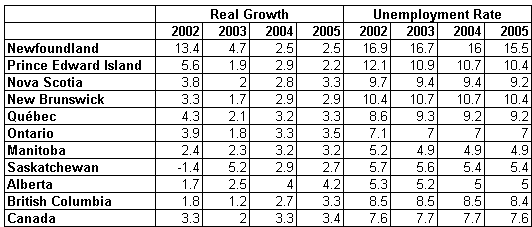News Releases
The Canadian economy will strengthen in 2004 and 2005, with economic growth rising from an anemic two per cent in 2003 to near 3.5 per cent during the next two years according to a report released today by BMO Financial Group. Outlook 2004 forecasts that not only will the national economy pick up, but the recovery will be broad-based across most provinces.
The key factor behind the brightening outlook is the strengthening of the U.S. economy. After expanding 2.9 per cent this year the U.S. economy will grow by 4.4 per cent and 3.8 per cent in 2004 and 2005, respectively. While stronger U.S. demand will support growth in Canada, the appreciation of the Canadian dollar will have a dampening impact on demand for Canadian exports as well as on sectors subject to import competition. This will soften the overall rebound in Canada. Thus, after outpacing the U.S. economy in the previous four years, Canadian growth will fall below that in the U.S. from 2003 through 2005.
“The strength of the Canadian dollar provides a challenge for the Bank of Canada,” said Tim O’Neill, Chief Economist, BMO Financial Group. “Though the economy will be strengthening, which suggests less need for such low interest rates, low inflation and the restraint on growth from the higher-valued loonie suggests there is no urgency to raise rates.”
The bank’s economists project the Bank of Canada will stand pat, leaving interest rates where they are until mid 2004. By the end of 2005, the central bank’s overnight rate is projected to rise from its current 2.75 per cent to 4.5 per cent.
Across the country, most regions will contribute to the pickup in national growth. BMO Financial Group’s economic forecast calls for Alberta to be the growth leader among the provinces next year.
“We see the main drivers of Alberta’s rebound being tied to both strength in natural gas prices as a stimulus to new exploration and development, and the expected removal of U.S. barriers to the import of Canadian beef products,” said O’Neill. Overall the rate of economic expansion in the province will jump to four per cent in 2004 and 4.2 per cent in 2005, up dramatically from the 2.5 per cent growth estimated for 2003.
Both Manitoba and Saskatchewan will also benefit from improved agricultural conditions. Outlook 2004 notes that the global supply-demand balance and the drought conditions in Europe and some parts of North America this year favour higher grain prices. Next year, both economies are projected to grow at a pace close to the national average. Manitoba’s economic growth is projected to increase to 3.2 per cent over 2004-2005 while Saskatchewan’s growth rates will be in the 2.7 to 2.9 per cent range.
Ontario and Quebec, with their export ties to the U.S. market, stand to benefit from the rebound in the U.S. economy.
“In 2004 Ontario will leave behind such temporary factors as the August 14th power blackout and the SARS crisis with its impact on tourism and other sectors,” said O’Neill. “Most sectors in Ontario have been struggling this year with the exception of home building and renovation but we expect the growth to broaden significantly over the next few years.”
Both Ontario and Quebec are projected to see growth rates of in the range of 3.2 to 3.5 per cent in 2004 and 2005.
The Atlantic provinces will grow by just under three per cent next year. For New Brunswick, Nova Scotia and Prince Edward Island, this will represent an acceleration that can be attributed to the general improvement in the North American economy.
For Newfoundland and Labrador, a growth rate of 2.5 per cent in 2004 will mean a drop from the 4.7 per cent growth this year. “Newfoundland’s strong growth levels over recent years have largely reflected increased production at the Hibernia and Terra Nova offshore oil fields,” said O’Neill. “Unfortunately that economic boost will not be a factor next year and will account for the weaker than average growth rate for the province.”
British Columbia is expected to see the second slowest growth of the Canadian provinces in 2004, as government restraint will offset some of the cyclical rebound. Even so, British Columbia’s economy is expected to see the sharpest improvement of the provincial economies over the 2003-05 period – going from 1.2 per-cent growth this year to 3.3 per-cent growth in 2005 as tourism, forestry and investment spending recover.
A full copy of Outlook 2004 can be downloaded from BMO Financial Group’s Internet web site, at www.bmo.com/economic.
Canadian Regional Outlook at-a-Glance
(All numbers are per cent changes, unless otherwise indicated)

-30-
